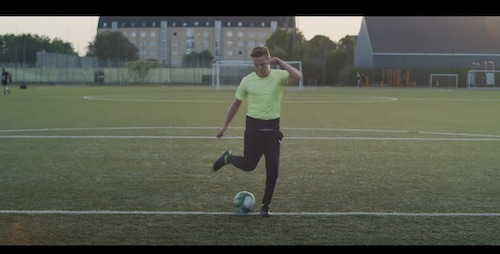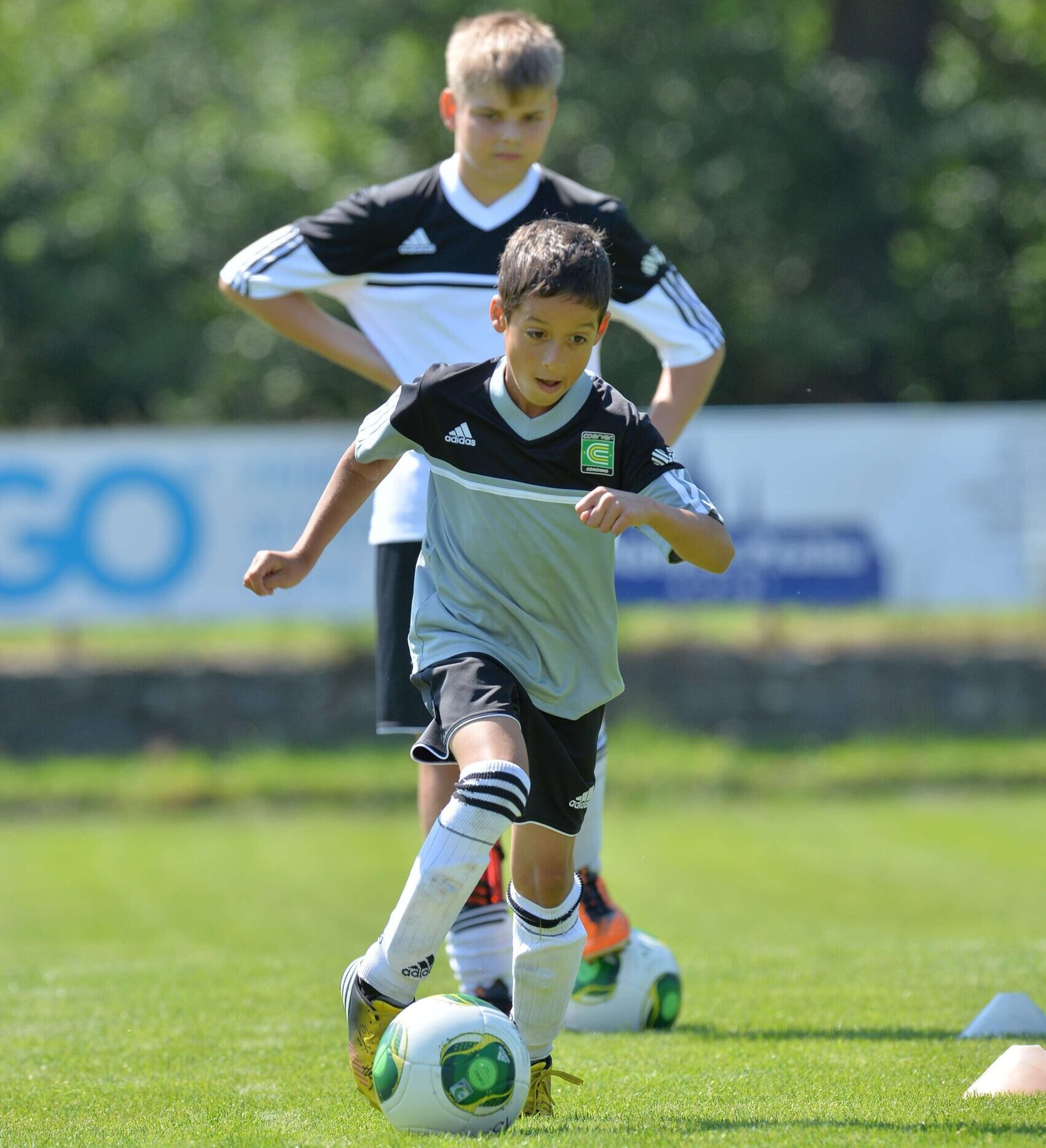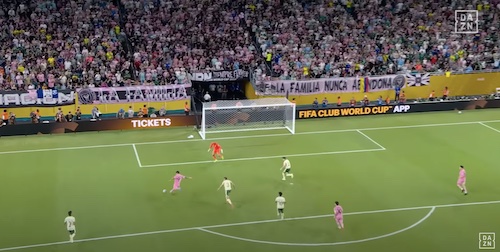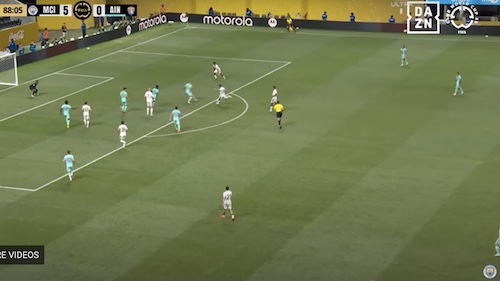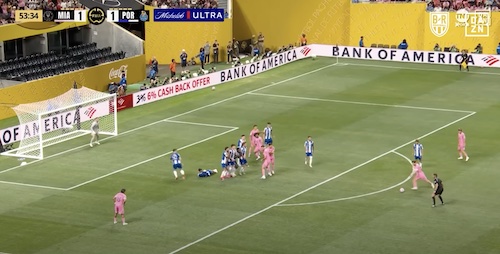Let’s look at training on your own and how to practice when you’re away from the team. When training on your own, sometimes it helps to get creative with your soccer training methods: As a kid, I would act like the weeds were defenders and dribble in and out of them in the yard or at the park, cutting back and forth as I dribbled, trying to avoid hitting the weeds with the ball, always keeping the ball close to me. I’d dribble slowly up to a clump of grass and then burst past it on the dribble as if it was a defender. Slow then fast. Change of pace is key to beating a defender.
I’d imagine I was playing soccer in a huge game and the crowds were cheering in amazement as I kept beating defender after defender. Nobody could take the soccer ball from me. I was like Diego Maradona against England in 1986.
Overall though, if you want to get better at soccer it’s all about spending time with the soccer ball, whether you’re juggling, dribbling or knocking the ball against a wall.
It’s also about having fun and trying to perfect what you’ve seen other soccer players do on YouTube or on TV during the World Cup or Champions League. Here are also some ways you can use to improve your soccer game on your own:
Touch the Ball with Every Step
When you’re training, get in the habit of touching the ball with each step you take the ball when you dribble. In very quick succession, touch the ball a little bit ahead of you with each step. This will create both good control and increase your dribbling speed. Exaggerate this when you’re starting out and learning how to dribble, so you touch the ball every time step and dribble the ball. First work on dribbling with each step only with the right foot and then switch over to the left.
With this kind of close control, you can elude defenders when they try to steal the ball. This close control also gives you the ability to cut the ball in either direction, since the ball is always close to your foot. Think about how Lionel Messi dribbles the soccer ball. The ball always seems like it’s tethered to his foot. He rarely dribbles the ball out in front of him unless he’s broken free from the defender on a breakaway.
If you exaggerate the idea of touching the ball with every single step, you will have much greater control when you are dribbling. It’s almost like you’re trying to get as many touches in as you can when you dribble forward with the ball.
Play Soccer with Older Players
Clint Dempsey said he learned a lot playing with Mexican players growing up in Texas. Not only was a skillful brand of soccer but it was tougher than the American leagues. Clint Dempsey said playing with these older and more experiences players help him become a much better players. So, see if you can play with other teams or players you wouldn’t normally play with – it’s a great way to learn and get better.
Change of Pace to Beat Defenders
Change of pace is the key to beating a player on the dribble. You don’t necessarily need great speed to go by someone, just a change of pace. Try to “lull the defender to sleep” for a second and then burst past the opponent at speed. The idea is slow, slow, slow and then when they least expect it you break away from the defender.
Look for that moment where the defender tries to dive in and win the ball or make a movement towards you, that’s when you break past them at speed.
Five Basic Football Skills
5 most basic football skills to learn. In this video Joltter teaches you 5 of the most basic football skills that are great for beginner level soccer / football players. These 5 basic football skills are a great way to start your football skills education as it’s crucial to know the basic skills before moving on to more advanced football skills. Watch the video, make some notes and go out to start learning amazing football skills!
Go Right at the Defender
Watch someone like Arjen Robben, who loves to take players on, he dribbles right at the defender, there’s no question he’s trying to dribble past them. When the defenders are on their heels or make a movement to try to win the ball, he goes right by them. He’s never afraid of a defender. Rather, they are very afraid of him.
They don’t want him to dribble the ball towards them. See if you can force defenders to make a choice, do they want to try to win the ball or give you space? If they give you space then you attack it with the ball and if they close you down they you can release the ball to a teammate or go past them if the chance is there.
One young player who knows change of pace and how to drive at defenders is Christian Pulisic. He’s not afraid to go right at a defender, which defenders hate.
Have a Soccer Plan
While you want to go right at the defender, and not give them time to think, you yourself want to have a plan and go at players at the right time and right place on the field. It’s not a good idea to try to beat a player in your own goal box. And, it’s not a good idea to try to beat someone on the dribble when there’s an open teammate to pass to.
When you are going to take a player on, try to beat them on the dribble, you have to see space behind them or know what you are going to do before you decide to take them on. Are you going to beat them and then take a shot? Are you going to beat them down the line and then cross the ball? Think about what you’re going to do before you decide to take them on.
Improving Your Weaker Foot
If you want to get better at dribbling, passing or shooting with your weaker foot, the best advice is to just use it – meaning the foot that isn’t as good as the other. Continue to dribble, pass and strike the ball against a wall with your weak foot and it will slowly improve over time. If you practice consistently, slowly but surely you will see a vast improvement. Have patience. The key is to work on the weaker foot on a regular basis, so set aside some time each day to kick the ball just with your weaker foot.
Keep in mind that there are always exceptions. If you look at one of the best players in the world, the Brazilian midfielder Rivaldo, he mainly uses his left foot. His left foot is so incredible and he positions his body so well to protect the ball, that he can get away with not using his right foot. He is a gifted and unique exception. To learn more about Rivaldo click this link – Rivaldo.
Of course, Rivaldo does have a right foot and uses it when he needs to. He’s just more comfortable using his favored left foot. Another player who is like this is Ryan Giggs, who is deadly with his left foot and tries to avoid using his right foot. But again, both players have are adept and skillful with their weaker foot, just not experts with this foot and so they use their stronger foot for the most part.
So, there’s the possibility that you weaker foot might never match your stronger foot in terms of comfort and skill on the ball. If that’s the case, then make sure you weaker foot is good enough to do all the simple things, like passing and trapping perfectly, but make your stronger foot incredible – as in you can beat players on the dribble and send in crosses with excellent accuracy.
If you watch a player like the Seattle Sounders Jordan Morris, he’s not comfortable yet with his weaker left foot. Morris wants to cross the ball with the outside of his right foot even rather than cross with his left. He’s got to get to a point where he’s more comfortable doing the simple things, like crossing or playing the ball with his weaker foot rather than be forced to play with his stronger foot. He doesn’t have to get to a perfect quality with weaker foot but at least get to a point where he’s more comfortable.
Soccer Drills to Help You on Your Way
An excellent dribbling drill is simply weaving in and out of a set of 5-10 cones in a line. This might seem like a simple drill but it’s good for all levels of players, whether you’re just starting out or an advanced soccer player. If it’s too easy then adjust the drill or put rules on yourself to make it more difficult. Make the cones a bit closer together or dribble only with your weaker foot. Challenge yourself. Maybe you try to see how fast you can dribble through the set of cones.
Place about 10 cones in a line about three yards apart and dribble in and out of each cone without touching or knocking over the cones. Keep the ball close and don’t dribble the ball too far away from the line of cones. And make tight and sharp turns when you are going back through the line of cones.
After you have mastered this, vary the way that you dribble through the cones. Try dribbling with just the right foot and then just with the left foot. Then try alternating feet, where you touch (pass) the ball to the left and then to the right as you weave through the cones with the insides of your feet.
Make up restrictions to put on yourself to try to improve a specific part of your dribbling technique. For instance, you might dribble only with the outside of the foot or only with the inside of the foot – and then only with one foot, the right or the left. Again, maybe you try to dribble as fast as you can through the cones and then dribble through the cones where you try to get the most touches on the ball you can.
Soccer Obstacle Courses
Try combining a shooting or trapping drill with a dribbling through a set of cones. This could be much like an obstacle course. For instance, a player stands towards the top of the goal box and the keeper kicks the ball out to him or her, they control it, and then dribble through the cones and take a shot. Look at this drill favored by Gareth Bale, where he arranges a large group of cones out in front and then weaves through them before taking a shot.
Maybe players dribble through a set of cones, juggle the ball ten times, make a long pass to a teammate, get the ball back, and then dribble back through another set of cones. You could setup two groups and make this a competition between the two teams – where the teams see who can get through the obstacle course the fastest.
Don’t Stand Around at Practice
If you’re a soccer coach, it’s key in any practice is to keep the games and drills flowing and not having a lot of stops and starts with too many people standing in line. You don’t want players to get warmed up and then get cold and bored waiting in line. Plan out a good practice and make adjustments when needed so players aren’t waiting in line. If there is some wait time between drills or games where one team sits out if they lose, then get the players to juggle or pass the ball in pairs or even do sit-ups and push ups. Practice you soccer moves when standing in line or waiting.
Soccer Move Highlight Clips











